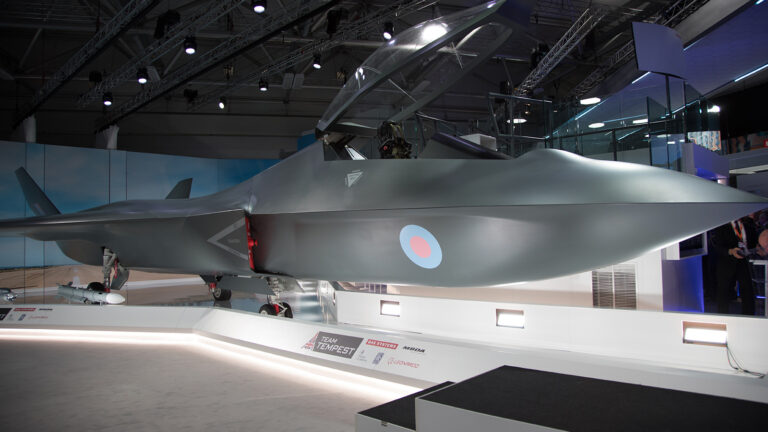Stay Up to Date
Submit your email address to receive the latest industry and Aerospace America news.
Britain wants to build a twin-engine stealth fighter jet that the Defense Ministry says would enable the United Kingdom to stay competitive in air-to-air combat technology and maintain its domestic fighter industry.
U.K. Defense Secretary Gavin Williamson unveiled a full-scale model of the Tempest at the Farnborough Airshow in July as a commitment that Britain would remain “a world leader in the combat air sector.”
The U.K. contractors chosen to design the plane must first present a business case for the fighter to the ministry by the end of the year to begin the approval process for funding. The ministry has promised to draw 2 billion pounds ($2.6 billion) for the Tempest over several years from the ongoing Future Combat Air System Technology Initiative enacted in 2015 that ends in 2025 to develop a successor to the twin-engine Eurofighter Typhoon.
Team Tempest, the name for the government agencies and companies working on the project, shared limited details about the design in progress beyond the concept they showcased. With their near diamond shape, the Tempest wings resemble those of the YF-23 stealth fighter demonstrator built in 1990 for the U.S. Air Force by Northrop and McDonnell Douglas, notes Adam Routh, an aerospace researcher at the Center for a New American Security in Washington, D.C. The YF-23 was flown in 1990 but lost the competition for the Air Force contract to what became the Lockheed Martin F-22 Raptor, which ended mass production in 2011.
The F-22 engines include thrust vectoring to maneuver the plane around enemy aircraft at close range, which the YF-23 lacked. Thrust vectoring engines were not presented as part of the Tempest concept, possibly because “next generation stealth and guided missiles may undermine the benefits of maneuverability by allowing planes to attack from a significant distance,” Routh says. Pilots of future air-to-air combat won’t often find themselves in dogfights won with maneuverability, Routh says, because guided missiles and stealth “will allow aircraft to engage opposing aircraft from a significant distance.”
Retired U.S. Air Force Maj. Gen. Mark Barrett, who from 2007 to 2009 commanded the first operational wing of F-22 fighters, says improved electronics, including sensors and data fusion to monitor the battlespace, are the best chance for Tempest to “take a generational leap.” Lockheed Martin F-35s, for instance, improved on the F-22s by adding a radar absorbent coating that is more durable against heat conducted during supersonic flight, Barrett says. Concealing engines to minimize heat signature and avoid infrared detection, and supercruise flight at Mach speeds without an afterburner are other “pretty darn good” stealth strategies the Tempest could include, he says.
Team Tempest consists of the Royal Air Force’s Rapid Capabilities Office, and U.K.-based contractors Rolls-Royce and BAE Systems, along with Leonardo and MBDA Missile Systems, which have British branches under the same Italy-based parent company.
Rolls-Royce aims to advance “the building blocks of the gas turbine,” for Tempest by “going to higher temperatures, advanced materials, ceramics, composite materials,” according to a company video clip of Conrad Banks, chief engineer for Rolls-Royce’s Defense Future Programs.
Britain hopes to have a fleet of Tempests in service by 2035 if funding is approved and is expanded after 2025. The RAF’s air combat fleet will include the Eurofighter Typhoons until at least 2040, according to a national air strategy also unveiled at Farnborough by Williamson, who called Typhoons “multirole combat aircraft.” The Tempest would fly both land attack and aerial combat missions based on this RAF multirole preference, says Mark Cancian, a former head of defense acquisition oversight at the White House Office of Management and Budget.
Bringing a Tempest fighter from concept to combat “is a very risky thing,” Cancian says, recalling the delays and higher-than-anticipated costs of building an advanced fighter plane he encountered at OMB during the ongoing F-35 program.
About Tom Risen
As our staff reporter from 2017-2018, Tom covered breaking news and wrote features. He has reported for U.S. News & World Report, Slate and Atlantic Media.
Related Posts
Stay Up to Date
Submit your email address to receive the latest industry and Aerospace America news.





